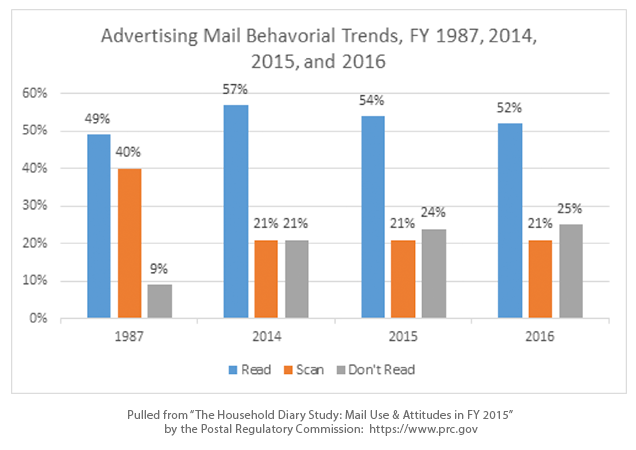3 Things to focus your Content on in 2022
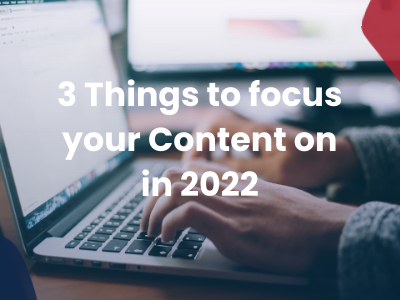
The end of the year always provides such a good time to reflect on trends and the direction we’re going! After a year with so many transitions across industries, privacy laws, and marketing channels, our focuses for next year have also shifted! One area to focus on in 2022 is content marketing.
If these last few years have taught us anything, it’s that content-based marketing really is one of the most important pieces of marketing. Your approach to content informs many aspects of business, not just marketing. Content covers all the ways you communicate. It’s tied to branding and mission and purpose and your focus. The type of content you produce helps you make decisions about marketing channels and our audience.
Content Trends 2022
With the rise of content marketing, ecommerce, and digital advertising, everyone acknowledges that social media, blogs, email marketing, etc. are all effective ways to sell people. The problem is that the very nature of content marketing erases the lines between education, entertainment, and sales. We have become so inundated with ads that our brains have been conditioned to go on the defensive when we feel like we are being sold.
An often-quoted marketing research study from 2007 found that the average American saw 5,000 advertisements a day. 5,000 ads a day pre-digital billboards, pre-Farmville, pre-Instagram, and pre-iPhone. Current estimates put the average number ads seen every day closer to 10,000. The 2007 study warned that number of ads cluttering our life would push for innovation in advertising that would in turn, create more clutter.
What can we do to cut through the clutter in 2022? Content marketing is an effective way because if done well, isn’t actually an ad and will actually reach the consumer.
Here’s three trends/focuses to incorporate into your 2022 content marketing.
Storytelling
This ties into the old writing rule: show don’t tell. Telling a customer how great you are won’t make them believe you. Showing them will prove it to them. But weaving a story around your product, brand, and successes will build an emotional connection between you and your customers.
Education
This goes hand in hand with storytelling and the inundation of advertising we all deal with. We have an excessive number of options to choose from. As well as our personal connection with brands, we use things like Social Proof to help us decide what products to buy. Brands can use this to their advantage by educating customers about their product instead of selling their product. The focus on pure information takes the pressure off the consumer to purchase. In turn, an educated customer is more likely to purchase.
Personalization
Even with increased privacy and data laws, there is more access to information about customers than ever. We often talk about personalized advertising in connection with retargeting and audience segmentation. It’s easy with personalization to focus on how specific and personalized you can get your advertising. ‘If someone clicks this and this and lives in these areas then we know all of this about them and can serve an ad for this specific product.’ That type of thinking is very valuable and helps you communicate effectively with your customers.
But personalized advertising doesn’t need to be that minute; it can be as simple as thinking about what channel you are using. Are you making blog content? What type of person reads blogs? You could build out a detailed buyer persona based on analytics and write with them in mind. That is very personalized! Or you could use common sense to tell you that most people who read blogs are probably interested in educating themselves, which also gives you a lot of information to personalize. The personalization can just be the focus of the channel. ‘These consumers are here to be educated, so we are going to educate them.’
Spotlighted Marketing Channel: CTV
Many marketers are using CTV (connected TV) or OTT (over-the-top) channels to target consumers using streaming services and connected TV devices such as Hulu and Roku. Advertisers are embracing these platforms as more and more ad space becomes available. Spending for CTV advertising grew from $6.94 billion in 2019 to $8.88 billion in 2020, a 28% increase.
Advertiser spent an estimated $8.88 billion on CTV in 2020
Read more about the future of CTV here!
What things are you excited to focus on in 2022?
4 Internet Marketing Terms You Are Probably Using Wrong
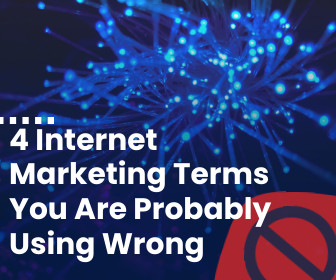
The internet and the marketing industry have something in common: They are full of terms and acronyms that can feel like an entirely different language. It can be super easy to misunderstand and/or misuse those terms. Here’s 4 “marketing/internet jargon” terms you are probably using wrong!
- Viral ≠ more views than you normally get
- Meme ≠ a picture with words on it. Please stop doing this
- Clickbait ≠ a catchy title
- Landing page ≠ a web page you’ve landed on
What do these words actually mean and how can you use them to communicate more effectively what you actually mean?
#1 Viral
What does it mean when you go viral? What makes something viral can be hard to quantify. There’s no magic number that means something is quote-on-quote viral. (Although MANY people try to make one.) Instead of defining viral by the numbers, it’s easier to quantify it by 2 things: reach and speed. The Wikipedia article on viral internet content makes the analogy that viral content is very similar to a virus. Viral internet content self-replicates and quickly spreads far from its original source. And often when content goes viral, it takes on its own life separate from what it was originally intended to be.
Let’s say one of your posts gets double or trip the amount of reach it normally gets. Is that viral? That’s very exciting, but no. Sorry! Although it’s possible to have something go viral with a specific community, viral implies exposure far outside it’s intended audience’s reach. With the number of platforms, and the cross-contaminating reach of those platforms, the general rule of thumb is over 2 million views in less than a few days to call something “viral.” This doesn’t mean that the content has to be a week old, it has to do with rate of expansion.
#2 Meme

This is one of my biggest pet peeves. It can be easy to look at a meme and think that any picture with words on it can be called a meme. It can be, but that doesn’t mean that it is. Meme was coined in 1976 by Richard Dawkins in his book on Darwinian evolution as an attempt to explain memetics; or, how ideas replicate, mutate, and evolve. What makes something a meme is not what it is, but instead the way that it replicates.
For example, the Star Wars “For the better, right?” meme has been a common format to use this month. What has made it a meme isn’t the original movie quote, or the format itself. It is a meme because many people are using or repurposing the format to convey information. Memes are only effective if the format conveys emotion or a message without it being explicitly stated and in a variety of different situations.

Although the types of memes we think of are usually in a concise image-based format, things like folk tales, urban legends, and chain letters are all versions’ memes. They are structured format in which information is shared and evolves.
#3 Clickbait
Are all catchy titles or hooks clickbait? No. The technical definition of clickbait is any text that is designed to entice a user to click or read on. However, the expression has a more specific connotation than that. It implies that the title isn’t accurate and is somehow disconnected from what you will see if you click. It’s similar to old school bait-and-switch marketing. Using bait or a hook isn’t wrong if you are looking to attract people, HOWEVER, the switch is wrong.
Clickbait is sensationalized content. An article titled “5 money making secrets you need to hear,” isn’t click bait if the article is actually about 5 money making tips. Which is part of what makes cracking down on malicious clickbait tricky. A lot of platforms like Facebook and YouTube measures in place to mark clickbait as spam. But how can AI decide if those 5 money making secrets are tips and tricks you actually need to hear? How does the platform know if those “secrets” can actually make you money? Clickbait is connected to consumer perception.
#4 Landing Page
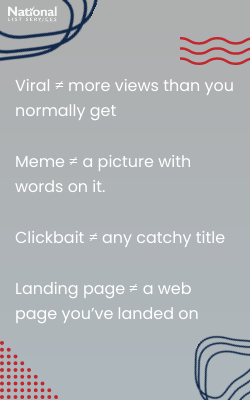
If you land on a webpage does that make it a landing page? No, because a landing page is a webpage you land on that is designed with a specific purpose in mind. One person illustrated it this way: You could use a baseball glove to retrieve a hot dish from the oven, but that doesn’t make your baseball glove an oven mitt. So just because someone lands somewhere doesn’t mean that it is a post-click landing page. The landing page could be designed get the user to make a purchase or fill out a form or watch a video. It doesn’t matter what the purpose is, it matters that it has one.
What is the advantage of separating your landing pages out to specify a single action? Research has shown that companies using 40 or more single action post-click landing pages generate 120% more leads than those using less than 5!
Do you have any marketing/internet terms misuse pet peeves?
Why Is It So Hard to Get a Good Marketing ROI?

Michael stood in front of the screen – palms sweaty and dreading the result – only to stare in shock at the number in the email. Just two measly sales… after all the cash he’d poured into this one marketing effort.
“How could I be so wrong? Will anyone trust me again?” If you’ve ever felt the anxiety bleeding through your team after a campaign like this, you’re not alone.
And fortunately, this nationwide homebuilder learned the big reason why they (and so many others) flounder so miserably with their marketing.
Knowing your audience is the key.
It seems this simple idea is pounded into us from every angle.
Companies “think” they understand.
They listen to the experts and read the articles. Yet when they send out offers to people, it’s obvious they really don’t know their audience. We hear about lookalike audiences, buyer personas and modeled propensities. It’s a great idea: reach your best prospects – the ones most like your best existing customers. And if it’s done right…
Michael decided on a short consultation and to try our data. He was a little cautious though, probably even a bit skeptical. “Let’s aim for 4 sales.”
When he got 12 sales and made $13.64 on every dollar he spent, Michael became a believer.
Knowing your audience is just this powerful.
And without a doubt, it’s the first step to make your marketing efforts effective in 2018.
How does it work? You start by sending a spreadsheet or list of your current customers. Maybe all you have is just their names and addresses. Likely there’s quite a bit of information on your customers. (In the sample below, we found data on 85% of our client’s customers.)
Sure, quite a few data companies could tell you the marital status, number of kids and simple demographics on your customers. But what about their political preference? Their hobbies? The way they connect to the internet? Their health, income, vehicles, even how they use their credit cards? (Obviously, due to privacy we can’t learn some of these things directly.)
If you analyze dozens of factors like these – with your best customers – you’ll start to see amazing trends. You can even see why they buy, and when. More than this, what if you could search through 250 million people, using these same factors?
You could find a CROWD of people with the SAME motives and timing.
Imagine what this can do for your sales and profits.
In the sample report below, notice these prospects are labeled “Best performers.” And there are 1.3 million of them.

Focus your best marketing efforts on these people.
And of course, this number could be narrowed down even further – even more targeted. For example, by using pre-defined propensity models, you can learn even more about people and how likely they are to behave like your existing customers.
Want to reach more people? No problem. There are 9.4 million “Undecided prospects.” People where some of the factors match, but they are less likely to buy than the “Best” ones. You could target them with a different kind of offer.
This is what an augmented lookalike report can do for you.
How do you feel about this? How do you get to know your audience? Want to get to know your audience like this?
Pick up the phone and call us.
We’re going to help some select companies exceed their marketing goals in 2018. Are you in?
| Click here to learn more |
Direct Mail is Still an Essential Part of any Marketing Strategy
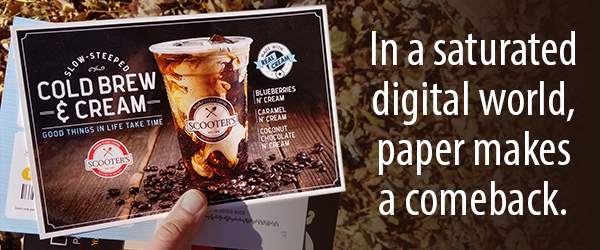 It would be easy to disregard the power of printed materials in a world on the verge of complete digitization. In terms of acting like consumers, there has been an obvious shift to the speed, efficiency and ultimate accessibility to our favorite products, brands and services via the Internet.
It would be easy to disregard the power of printed materials in a world on the verge of complete digitization. In terms of acting like consumers, there has been an obvious shift to the speed, efficiency and ultimate accessibility to our favorite products, brands and services via the Internet.
In fact, any modern marketing strategy is almost obligated to allocate a significant amount of resources to digital efforts: designing a sleek, user-friendly website, devising email campaigns and pushing social media to increase overall presence.
The immense proliferation of technology in the last few years would suggest that any need for a printed, direct mail strategy has been negated. However, in the pursuit of high-performance marketing, this is still a hugely valuable asset that when combined with powerful big-data insights, can bolster your overall strategy and ultimately boost sales.
Print’s dead, though, right?
Not only is direct mail still a viable marketing tactic, it could actually provide your company with an opportunity to stand out amidst all of the competition we now find online. While it shouldn’t be your company’s sole tool, it can act in a complementary role in terms of accessing your customers at the right time with a relevant message. While digitization has forced the newspaper and magazine industries to downsize and adapt, companies are still finding benefits from mailing their customers directly.
Why? For several reasons. First of all, it can be your company’s personal touch.
Mobile data is giving marketers better insights into what consumers are searching for, what they’re trying to purchase and when. This is critical in terms of designing targeted approaches to ensure consumers are actually benefiting from your marketing. However, it’s easy to lose any kind of personalization when everything is automated. With more complete and accurate mailing lists–informed by big-data–direct mail is still the standard for reaching out to customers with a personal touch.
 We still want very real things in our hands, which is something totally lost in email inboxes.
We still want very real things in our hands, which is something totally lost in email inboxes.
The flexibility of direct mail allows you to create something that can reach into consumer psyches more deeply than well-crafted emails. Something that is attention grabbing, boosted by rich visuals (as opposed to lengthy text on a screen), with a simple progression that directs the customer to follow your desired call to action, can propel consumers to either act or at least take notice.
Keys for an effective direct mailing strategy, in terms of the actual materials being sent (according to the Data & Marketing Association):
Be bold.
We have short attention spans. Marketing that cuts through the clutter with attention-getting graphics and copy more apt to gain and hold that attention.
Visuals rule.
In fact, the brain processes visuals exponentially faster than the time it takes the brain to decode text. Well used imagery can quickly get your piece noticed, and your message across.
Keep it simple.
Direct mail that creates a simple decision path with limited copy and explanation always tests better.
Furthermore, in an industry that finds immense value in data, direct mail can be directly measurable.
The United States Postal Service is an integral part of our country’s overall mailing industry. In fact, because it can deliver mail to every address (Every Door Direct Mail), companies like UPS and FedEx often piggyback off of its services. This is important because the USPS is able to constantly measure how much mail is coming and going, what kind of mail is being sent, and even whether or not people are reading their mail.
The United States Postal Service almost does the work for marketing researchers.
A large part of this is accomplished by the Household Diary Study (HDS), a survey that’s been conducted by the USPS since 1987. The metrics from this survey can provide insight to companies trying to make the most of their direct mail efforts. These metrics include total mail sent and received by households based on different demographics ranging from the age and size of households, education and income levels, and access to the Internet. According to this survey, in 2016 advertising mail represented 62 percent of all mail sent and received by households (about 79 billion pieces of mail). The culmination of this data, paired with the insights of mobile and big-data , make it possible for your company to appropriately and accurately determine how best to approach consumers.
Advertising Mail Received by Income and Education (Pieces per Household per Week)
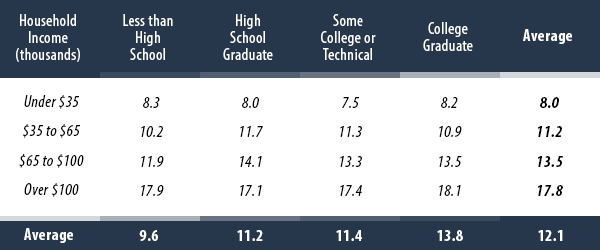
Advertising Mail Received by Income and Age (Pieces per Household per Week)

“73 percent of households either read or scan advertising mail received”
Ok, but what about the cost?
In terms of how cost-effective direct mail can be, it depends on how you decide to approach it. It can be expensive, especially if you’re sending out large catalogs chalk full of visuals and designs that require professional work such as copywriters, photographers, designers and printers. Opting for First Class mail (which means reaching your customers faster) can also bump the price up, but because of how flexible direct mail can be in general, it’s a cost-effective strategy that can be tailor made to fit any budget.
Contact us to learn more about how Direct Mail marketing can boost your prospecting.
| Click here to learn more |
The Shocking Truth About Your Marketing Channel
 Many people still believe you only need one marketing channel – and they couldn’t be more wrong. For example, malls are lined with countless businesses. And most of these shops rely solely on one thing: a crowded mall area to bring people inside to buy.
Many people still believe you only need one marketing channel – and they couldn’t be more wrong. For example, malls are lined with countless businesses. And most of these shops rely solely on one thing: a crowded mall area to bring people inside to buy.
Analyst Jan Kniffen says one-third of all the big malls in America will close their doors over the next few years. Nearly two-thirds of the remaining malls will struggle.
Industry veteran John Hazen asked his peers at a recent conference: “Is anyone not seeing large traffic declines?”
Why Single Channel Marketing Is Killing You
Consider this scenario: Brandon McDonald, of Nashville, Tennessee, walks into a local store. Brandon is excited about the Nikon digital camera he’s planning to buy and have in his hands today. Yet when he gets into the store, he decides to scan and check the price with an app on his phone. An online company is selling the same camera for less than what the store is now offering. Brandon decides to buy online and wait for his camera to arrive.
Why Selling Online Doesn’t Fix This Problem Either
Remember, Brandon first wanted to buy from the local store. Like so many customers, he loves to hold the camera in his hands–instant gratification. If only the store knew what Brandon wanted. It would have been win-win for Brandon and the store.
This problem doesn’t just plague retail stores and physical products.
The Secret To One Bank’s Success
One regional bank depended almost entirely on people walking into the bank and asking for a loan.
Yes, they have a website. But only about 1% of web visitors were submitting a loan request. The bank decided to look at data for their mobile and online visitors–surprise! They could recover the business of a significant number of people who abandoned the bank’s online loan form. Sales of current-account and personal loan products shot up 25%.
This is just one way that mobile insights are changing the face of marketing. And moving the whole world toward multi- and omnichannel marketing.
![]() Your Customers Expect Multi & Omnichannel Marketing
Your Customers Expect Multi & Omnichannel Marketing
As you can see, marketing to people through multiple channels or methods increases your ability to sell and profit. Omnichannel marketing means tying these methods or channels (apps, digital tools or shopping venues) together in an easy-to-use, consistent way for even more profit. More and more, customers are expecting this kind of buying experience. They want to hop on their phone or device and see exactly what inventory you have available. Or they want to shop online and pick products up at your local store.
The Numbers Don’t Lie
Rice University studied 46,000 shoppers for a 14-month period.
Only 7% shopped online exclusively. And 20% visited stores without using any other apps or venues. A whopping 73% used multiple channels in their shopping journey. These multi/omnichannel shoppers absolutely love touchpoints – in all sorts of combinations and locations. Touchpoints like offers to compare prices and download coupons.
In fact, they are avid users of all sorts of mobile tools such as interactive catalogs and price checkers. They bought online and picked up at the store. They bought at the store and got their products shipped.
Multi-channel and Omnichannel Shoppers Are More Valuable
And those who used multiple channels spent 4% more in the store and 10% more online than the single-channel folks. In fact, those who used 4 or more channels spent 9% more in-store than the one-channel shoppers. And those who used apps to research online first? They spent 13% more in-store. Six months after these shoppers had their first omnichannel experience, they were shopping 23% more. And they were far more likely to recommend their chosen brand to friends and family.
The “Killer App”
No wonder many are calling omnichannel marketing the “killer app” – because it’s saving the future of so many businesses. Despite the bleak future of single-channel businesses, you now know the secret that empowers you to reach your customers at the right time, with the right message. It’s why the most successful marketing campaigns today are omnichannel campaigns. It’s how you give your customers what they really want.
How will you use omnichannel marketing?
Contact us to learn more about how multi-channel & omnichannel marketing can improve your prospect marketing.
| Click here to learn more |
Our thoughts and prayers to our friends, colleagues, and partners affected by Hurricanes Harvey and Irma.
 The Impacts of Hurricane Harvey
The Impacts of Hurricane Harvey
Governor Greg Abbott of Texas is calling the storm one of the largest disasters America has faced. Our hearts go out to anyone who is affected by the storm. We, and our partner, MCH Strategic Data, will continue to monitor the situation.
MCH has identified the zip codes of affected schools and buildings in the area. Our account and relationship managers will also keep you abreast of potential interrupted mail services by the United States Postal Service.
For more information on how Hurricane Harvey impacts mail delivery, visit the USPS web page or call 1-800-ASK-USPS (1-800-275-8777) to obtain information, including available, alternate Post Office retail locations.
The Impacts of Hurricane Irma
On the heels of Hurricane Harvey, the United States is preparing for yet another tropical storm likely to affect the state of Florida. Hurricane Irma is expected to bring devastating winds to much of the state, regardless of the exact track of the center.
As a result of the storm, USPS operations have ceased in certain zip codes. The situation may also impact email delivery to institutions located within those areas. We will be monitoring daily updates provided by the USPS.
When available, we will have a suppression file of the affected zip codes if you are planning on mailing to institutions in the area.
We also encourage you to monitor the daily updates provided by the USPS by visiting the link below, and clicking on the “Mail Service Disruption Report” link on the right.
http://about.usps.com/news/service-alerts/business-weather-updates.htm

